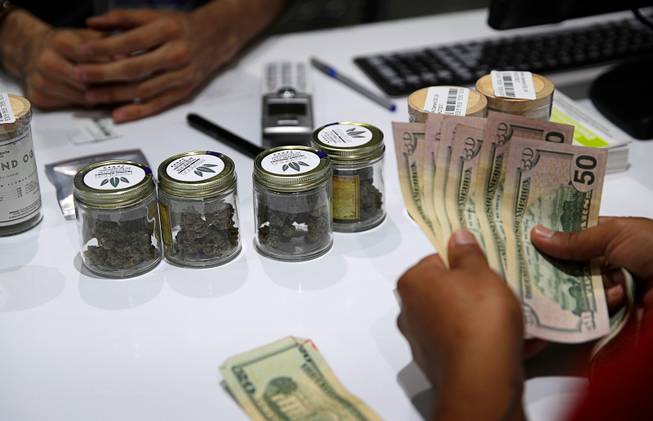
John Locher / AP
A customer buys marijuana at the Essence cannabis dispensary in Las Vegas, July 1, 2017.
Friday, Sept. 14, 2018 | 2 a.m.
Related news
Marijuana prices in Nevada could soon decrease to fall in line with those in more affordable marijuana legal states like Oregon and Colorado, a leader in Nevada’s marijuana industry said Thursday.
Speaking to a crowd of more than 100 at the Las Vegas Medical Marijuana Association’s monthly luncheon, Acres Cannabis CEO John Mueller said price reductions could come as early as next year when up to 42 additional state dispensary licenses are issued for new pot stores to open across the state.
“We charge way too much money for this stuff,” Mueller said. “It’s going to come down.”
A gram of marijuana flower normally costs $12 to $20 at dispensaries across Nevada — the same quantity of pot can be purchased legally in Portland and Denver for $6 to $10. An eighth ounce of flower, priced at $35 to $70 in Nevada, runs from $17 to $50 in Oregon and Colorado’s largest cities.
Nevada’s comparatively high pot prices are due to costs paid by dispensaries to state-mandated testing labs and a tax on the plant as high as 38 percent in some cities by the time the pot reaches buyers.
But as the industry expands to include more dispensaries and cultivation facilities, Mueller said more pot supply will force shops to compete for customers. Nevada has less than one-eighth the number of open dispensaries in both Oregon and Colorado, and costly lab testing standards for those states are not as stringent as they are here.
The current discrepancy in price isn’t necessarily a knock on Nevada’s marijuana industry, cannabis consultant Jeremy Jacobs said. The Kentucky-based consultant, speaking at the Thursday event, said a “decent balance” between the number of cultivation facilities and dispensaries has helped Nevada’s industry continue to grow as a “fair pace.”
High supply of pot, thanks to hundreds of cultivation facilities, has played a role in the overproduction and waste of the plant in other states, he added.
Both Mueller and Jacobs said they expect access to the industry — for both consumers and business owners — to become easier in the next few years if and when the federal government removes the plant from its list of Schedule 1 illegal drugs. Mueller said consumer recognition of brands, similar to a beer drinker ordering “Michelob or Bud Lite,” will also grow, reducing customers’ need to rely on budtenders for marijuana advice.
“We want to take it out of our hands as dispensary owners and allow consumers to interact directly with their favorite brands,” he said.
